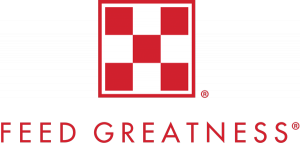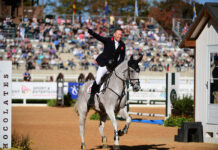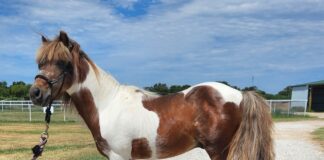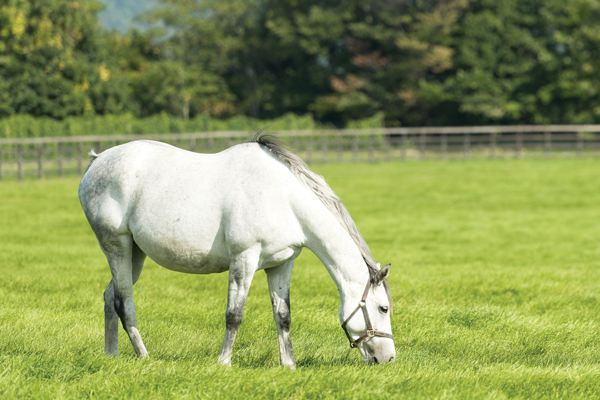
Spring is here, or at least on its way! Part of your horse’s health plans should include a sound nutritional strategy. With the warmer weather, rain and increased pasture turnout, now is a good time to put together a game plan that will keep your horse at a healthy weight while providing a balanced diet. Let’s look at how you can tune up your nutrition program for your horse for spring.
Monitor Your Horse’s Weight
A SCALE: While this might be the most accurate, you’d have to find a veterinary clinic or auction barn with a livestock scale, or haul your horse to a commercial scale (often found at truck stops), weigh your rig with him in it and him not in it to get the difference.
BODY CONDITION SCORING: The Henneke body condition scoring (BCS) system requires using your hands to feel for fat deposits along the neck crest, shoulders, rump and tailhead to determine his BCS, ranging from 1 (emaciated) to 9 (obese). Scores between 4 and 6 are usually recommended, depending on what the horse is used for. A 4 means ribs are just barely visible, and at a 5 they can be easily felt but not seen.
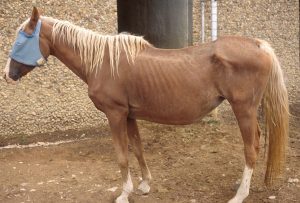
at different horses. This horse has a BCS of 2. Photo by Nancy S. Loving, DVM
WEIGHT TAPES: Weight tapes don’t give you an accurate weight, but are helpful for comparing your horse’s relative gain or loss over time.
PERIODIC PHOTOGRAPHS: These are helpful for detecting subtle differences that you might not notice every day, but they’re best used in conjunction with another method.
THE FORMULA: Get a more exact weight by multiplying heart girth x heart girth x body length, and divide that number by 330.
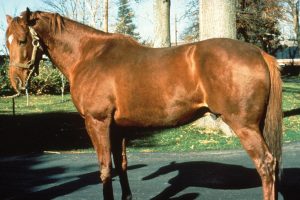
Heart girth is measured in inches around the barrel just behind the withers, and body length is measured in inches from the point of the shoulder to the point of the buttocks.
Exercise Expectations
After you know your horse’s starting weight, you’ll need to evaluate what you expect your horse to do in terms of work and difficulty so you can feed him accordingly.
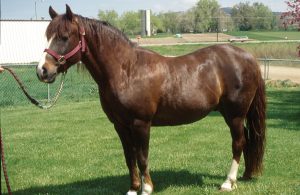
It’s estimated that over 50 percent of adult light-breed horses in the United States suffer from obesity; the usual reasons for this are too many calories coupled with too little exercise. Therefore it is very important to avoid overfeeding, which gets your horse too plump or even obese. At the same time, you’ll want to provide sufficient nutrients. In many cases, less is more.
Forage First
No matter the time of year, forage (hay and/or pasture) is the keystone of a horse’s diet. A high-forage diet—at least 60 percent of the horse’s daily feed by weight—maintains intestinal movement, provides useful nutrients, and helps move sand, dirt and debris through the bowels. The ability to munch periodically throughout the day also helps a horse’s mental state.
Horses are much happier eating more forage over a longer period of time than if they are offered calorie-dense feeds in the form of grains or concentrates. The feeding of high- calorie diets often means cutting down on how much hay (or pasture) is fed. Forage is much healthier for a horse’s gut and mind.
Most horses in light or average work don’t need supplemental calories; good-quality hay should be sufficient. Use of a slow feeder or small-hole net slows consumption of hay and keeps forage in front of the horse so he can “graze” throughout the day, especially during the spring as your horse’s nutrition starts to be more from pasture.
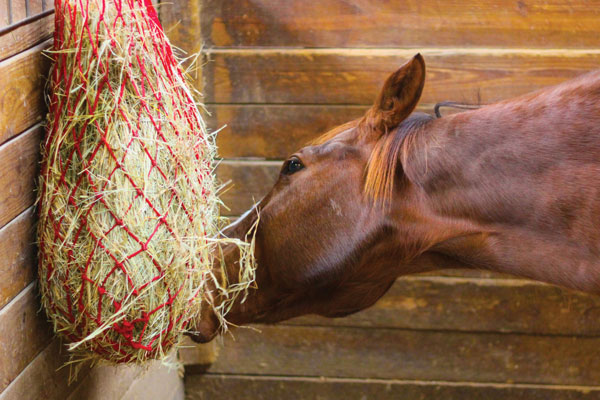
This feeding practice mimicks natural grazing of small amounts over 12 to 16 hours per day. The horse also isn’t as likely to develop vices due to boredom from long fasting periods between rapidly consumed meals.
Feeding supplemental calories—grain, complete feed pellets, and fat in the form of oil and/or rice bran—is usually only necessary for horses in regular hard work, such as endurance or eventing, or for those that have difficulty maintaining enough weight. Due to intestinal fill, hard-working horses often aren’t able to consume enough forage to compensate for calories burned, so additional feed is necessary to provide enough energy and nutrients.
Pasture Effects
The big consideration in springtime is how to adjust the diet, since horses may be out on pasture more. It’s best to bring your horse through winter with a light layer of fat over his ribs, but not too much. You should be able to just feel the last two ribs when running your hand across your horse’s barrel. It takes very little time to plump up a horse when you turn him out onto sugar-rich, lush spring grass.
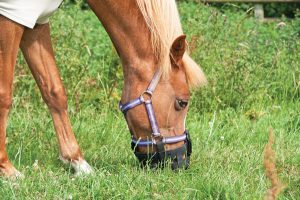
You may need to back off or eliminate dietary supplements, especially high-calorie products that you may have been feeding over the winter. Fresh pasture contains abundant calories. You’ll want to fine-tune your dietary approach for each individual based on his work level, time at pasture, pasture quality, quality of additional forage being fed when he is not on pasture, and how hard or easy a keeper he may be.
Some easy keepers fare better if turned out with a grazing muzzle, which can reduce intake by as much as 80 percent when used correctly. For greedy eaters, you may need to close down the hole at the bottom of the muzzle a bit more with strong tape, particularly if the horse is turned out on long grass that sticks up into his muzzle bucket.
Some horses with metabolic issues (equine metabolic syndrome, insulin dysregulation, or Cushing’s disease) shouldn’t be turned out on spring pasture at all.
How to Safely Add Pasture
For horses that can enjoy pasture, turnout should start slowly and gradually to allow your horse’s gut microflora time to adjust to the dietary change. Start with 10 to 15 minutes once or twice a day. Every five to seven days, double the total time allowed on pasture.
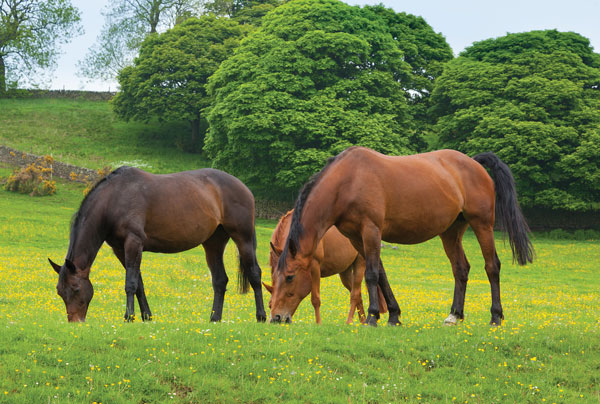
After slowly increasing time on lush pasture, most horses should spend no more than four to six hours a day on pasture. In most situations, even a hard keeper should be allowed to graze spring grass for no more than 12 hours a day. A dry lot can be used for the other 12 hours.
When possible, turnout for two sessions a day is better than turnout for extended, uninterrupted hours. Turnout in the early morning is safest because sugars have been used up by the plants overnight; the highest sugar levels in pasture occur in the afternoon and early evening hours.
Before turning a horse out, it helps to offer hay. Some intestinal fill controls hunger and lowers pasture consumption.
The Bottom Line
Horses evolved to plump up in times of plenty and lose weight in lean times over the winter. Nowadays, our horses receive ample nutrition year-round without any real opportunity to thin down. This makes for a dangerous situation in spring when the lush grass provides excessive sugars, fructan and starches.
Horses evolved to plump up in times of plenty and lose weight in lean times over the winter. Nowadays, our horses receive ample nutrition year-round without any real opportunity to thin down. This makes for a dangerous situation in spring when the lush grass provides excessive sugars, fructan and starches.
Monitor each horse’s body condition score to fine-tune his diet. It’s always best to err on the side of caution during spring dietary changes, especially those that incorporate pasture.
To ensure you are providing enough nutrients and the right kind—especially since every horse is different—talk to your regular veterinarian or an equine nutritionist about your horse’s individual needs.
Q&A on Horse Spring Nutrition with Purina
Feeding decisions should be based on the condition of the horse coming out of winter and your springtime goals. Here are a few examples: ■ If you have an older horse that had a tough winter, it may be time to consider a senior feed and/or a weight gain program. Q: What are the biggest pitfalls owners should avoid? A common springtime mistake is to stop feeding hay too soon. You might look out at a green pasture and think that there’s plenty of lush, nutritious grass available. however, early-season grass can be very high in water and low in fiber content. At this stage of maturity, pasture may not meet a horse’s minimum requirement for dry matter intake. it may be necessary to provide 10 to 15 pounds of hay per day until the pasture matures to avoid inadvertent spring weight loss or overgrazing of pastures. Q: What is a ration balancer and what are the benefits of feeding one? A ration balancer is a concentrated feed that packs all of a horse’s daily protein, vitamin and mineral requirements into a small volume, usually 1 to 2 pounds per day. they are meant to balance the nutrition of forages or unfortified grains, and provide the same nutrition as 3 to 4 pounds of a commercial grain mix without the added calories. A ration balancer is a great option for easy keepers or metabolic horses, horses with access to excellent forage, or any horse that maintains weight on a low volume of feed. Q: What questions should horse owners ask of a nutritionist or veterinarian when developing their horse’s spring nutrition plan? Spring is the right time to consult with your vet or nutritionist on many types of horses. All horses should have their body condition evaluated and be put on an appropriate weight gain or loss program. here are a few examples: ■ A horse emerging from winter in poor condition may need his teeth evaluated, and it may be time for senior feed or another forage replacement if he no longer chews or digests hay well. Make changes slowly and be patient. Don’t implement crash diets for overweight horses, and remember that weight gain takes time. A good weight gain program will put on about 1 pound per day. Anna C. Pesta, M.S., Ph.d., is a member of the Equine Technical Solutions team at Purina Animal Nutrition. she spends her time consulting with horse owners and veterinarians on the East Coast, bringing nutrition innovations from research and development to the field. She rides her own horses in Aiken, S.C. |
This article with spring nutrition tips for your horse appeared in the March 2020 issue of Horse Illustrated magazine. Click here to subscribe!

